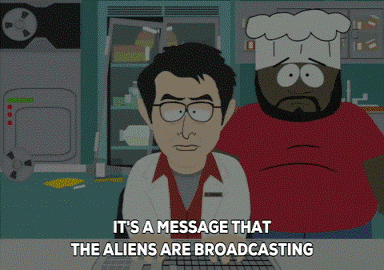Unscrambling Gartner’s 2023 tech trends: bye-bye jargon
13.07.2023
4 mins read
No shade, Gartner. We like your work. But here’s a thing. After a deep dive into your 2023 top technology trends, we noticed something. For many folks, your tech-terminology might as well be alien code.

So we’re buckling up our ‘tech-speak translator’ belts to tackle this. Dear readers, here are the tech trends you might want to clock (or disregard) for 2023 – the Gartner edition, but with the tech jargon stripped out.
Trend 1: Digital Immune System
A digital immune system does multiple security tasks to protect your business. It detects threats, blocks harmful activities and adapts to new cyber threats.
It has a firewall that stops unwanted intruders, like someone trying to gain unauthorised access to your network. Intrusion detection and prevention systems look for possible threats. For example, they spot if someone’s making too many login attempts. Antivirus and antimalware software find and get rid of harmful elements, like a virus trying to damage your files.
It also helps those computer boffins sound more fancy at parties. Because saying “I make digital immune systems” definitely sounds cooler than “I turn the firewall on and off”.
Trend 2: Applied Observability
Applied observability is a tool that actively monitors your business data. It continually adjusts systems based on the data it collects and offers strategic advice.
Tesla uses applied observability in their cars. They’re fitted with different sensors and software to monitor your driving real-time. All this information gets logged into a digital dashboard – a tool that displays real-time updates and key data. It keeps tabs on your speed, your cornering finesse, and whether your braking style is more Fast & Furious or Sunday driver. This culminates into what’s known as your ‘Safety Score’, and Tesla adjusts your insurance premium based on this score.
That’s Tesla’s deployment of applied observability – using real-time data to make informed and beneficial decisions. Now if only Elon Musk could apply the same principle to his own decision-making…
Trend 3: AI Trust, Risk and Security Management (AI TRiSM)
AI Trust, Risk, and Security Management (AI TRiSM) is a system that makes sure artificial intelligence (AI) follows the rules, respects private information, and can handle unexpected situations.
The Danish Business Authority has a smart system that pairs AI and ethical principles. It closely monitors AI activities, such as algorithms – which are just a set of instructions or rules that a computer follows to solve a problem or complete a task – making decisions on loan approvals, ensuring there’s fairness in the process. With this proactive setup, they efficiently manage eye-watering financial transactions.
So, in nutshell, we’re all like kids in a candy store with these bright, new AI toys, figuring out what jobs they can do. We need some playground rules. That’s where AI TRiSM swoops in, laying down the law and ensuring no one’s skipping the line. Here’s to hoping it keeps us in check until the AI uprising.
Trend 4: Industry Cloud Platforms
Industry Cloud Platforms provide tailored software and services, helping companies streamline operations, foster innovation, and achieve a competitive advantage by addressing unique industry challenges.
Intermountain Healthcare uses an industry cloud platform. They selected a platform from a provider with a name straight out of a 12-year-old Star Wars fan’s dream – ‘hyperscale.’ Fancy term, but it’s really just a mega-sized online hosting service – a huge server on the internet that stores and manages a lot of websites and data.
Intermountain Healthcare is using this industry cloud platform to enhance user experiences and innovate. For example, they might use it to quickly analyse patient data, providing faster, more personalised healthcare services. The catch? These platforms can be as tricky to manage as a podrace on Tatooine. You need to understand the data, maintain the software, and handle any hiccups.

Trend 5: Platform Engineering
Platform engineering is … well, it’s not exactly new. You’re picking the right tech tools for the job at hand, such as specific software, applications and systems that are best suited to perform certain tasks.
Gartner shines the spotlight on Nike’s platform engineering. Nike has crafted ‘composable platforms’ (think of it as tech Lego – different pieces can be used, shuffled around, or swapped out as needed) loaded with precisely chosen tools. Perhaps there’s a tool for 3D sneaker designing or software that sifts through sales data, guessing which running shoe colour will fly off the shelves next season.
It’s like having a tailored tech toolbox for each job to make the work as effortless as tying your shoelaces. But let’s cut through the buzzwords. Simply put, we’re discussing the core software a company uses – like tools for designing products or predicting sales.
Trend 6: Wireless-Value Realisation
Wireless-value realisation is about boosting profits by wirelessly connecting all business tools – like computers and inventory trackers – to improve overall efficiency.
For instance, Shufersal, an Israeli retailer, leverages this principle by using power harvested from the network for Internet of Things (IoT) chips. IoT is just a fancy term for everyday items like fridges or phones connected to the internet for smart, automated functions.
These chips track their products from farm to store, enhancing supply chain efficiency, inventory management, and providing detailed product origin info. With fewer items going to waste and the bonus of potentially charging a bit more for this top-notch tracking, their profits get a nice little boost.
Despite the fancy ‘value-realisation’ term, we’re just talking about making bank. And, if you’re turning wired into wireless, chances are, you’re making more bank.
Trend 7: Superapps
Superapps are like having a bunch of small apps in one big app. They seem handy, but often they’re just reused old ideas and might be more trouble than they’re worth.
Remember the 2000s? Trillian, a software that combined various messaging and email services into one, was all the rage. Today, we’re seeing a similar trend. Companies like Revolut are promoting superapps – platforms that bundle together various services. But history has taught us a lesson: users often find these bundled services overwhelming, leading companies to eventually separate their services again.
So, instead of jumping on the superapp bandwagon right away, perhaps it’s wiser to wait and see how this trend pans out before we find ourselves hitting the ‘rewind’ button once again.
Trend 8: Adaptive Artificial Intelligence (AI)
Adaptive AI improves with experience. It’s different from generative AI, like Open AI’s ChatGPT. The adaptive type becomes more efficient at tasks as it gathers new data over time, constantly fine-tuning its performance.
Dow, a chemicals powerhouse, deploys adaptive AI. They use it to streamline their business, and with every bit of data it processes, it gets smarter. But it’s not always easy. It involves complex technical work and fast-paced problem-solving. Plus, these AI systems need to be flexible, ready to adjust quickly to new situations.
And they’re ravenous for data. The main course? Our interactions. So, it begs the question: Is this groundbreaking tech or sophisticated digital pickpocketing?
Trend 9: Metaverse
The Metaverse, accessible via devices like virtual reality (VR) headsets or smartphones, creates a whole new virtual 3D world or enhances our reality with digital elements.
Take OneRare, an Indian startup diving into the world of virtual reality. They’re offering a gamified experience where food lovers can pretend to munch on their favourite meals in a virtual world. At the same time, this platform helps food brands showcase their products to a global audience. Honestly though, the idea of pretend eating just makes us sad. It’s a concept that might tickle the fancy of some, but frankly, it seems like a recipe for disappointment.

Despite all the buzz, the Metaverse feels like an overcooked trend that has yet to deliver a truly appetising experience.
Trend 10: Sustainable Technology
Sustainable tech, like solar energy solutions and waste management systems, boosts our planet’s health, community well-being, and corporate fairness.
Dubai Electricity & Water Authority uses the Internet of Things (IoT) – devices connected over the internet – to manage buildings smartly and cut water usage by half. Some companies are promoting the ‘circular economy,’ an idea about reusing and recycling to reduce waste. For example, Apple uses robots to recycle parts of old products, and IKEA, a firm believer in this cause, has even publicly shared a guide on designing products to be easily recyclable or reusable.
It’s a step towards saving the planet and ticking off environmental, social and governance (ESG) boxes. But it’s not a magic wand for all our environmental woes. It’s just one part of the larger picture of sustainability.
So, there you have it
Gartner’s Top Strategic Technology Trends for 2023, but with a bit more sass and a lot less tech-jargon.
Remember, trends are just tools. Real progress comes from tailoring technology to fit you, not chasing the shiniest new gadget. The best tech empowers people, instead of making them feel redundant. As we peek into the future, let’s temper our excitement with a dose of critical analysis. After all, not all that glitters is gold, or should we say, not all that beeps is tech worth our attention.
Want more unsolicited but oddly satisfying tech de-jargoning? Click your way to our LinkedIn, Twitter, and Spotify. You won’t regret it… probably.
